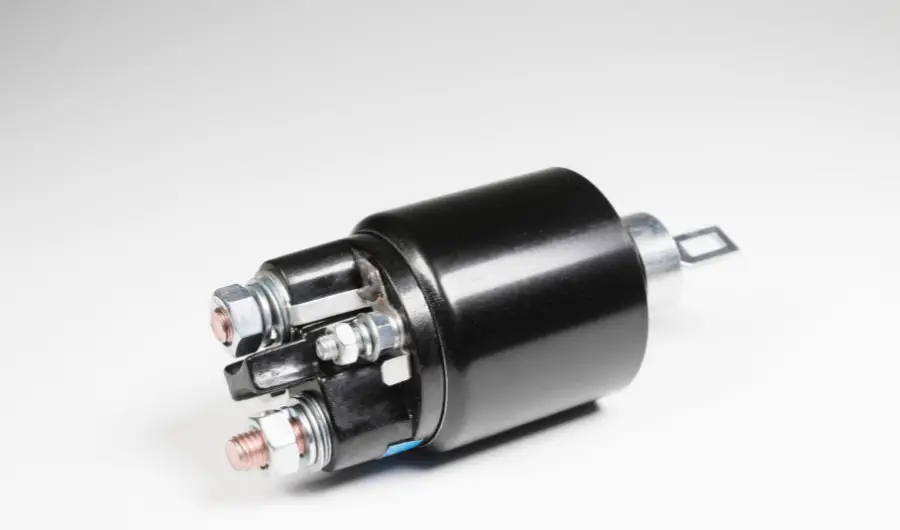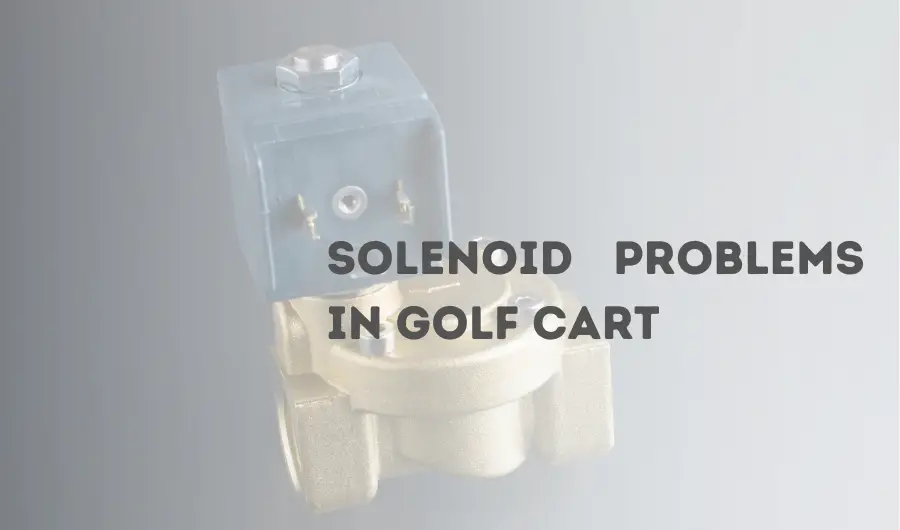If you own a golf cart, you know how frustrating it can be when it doesn’t start or experiences recurrent issues. I’ve been through these situations myself when my trusty golf cart decided to throw a tantrum right in the middle of a beautiful sunny day on the course.

A major cause of such unannounced inconveniences is a bad solenoid.
The solenoid is an important component in the electrical system of a golf cart. It acts as a switch that controls the flow of electricity from the battery to the motor, allowing the cart to move. Whether your cart has intermittent starting issues, strange clicking sounds, or even sudden loss of power, all of these indicate a faulty solenoid. Identifying and addressing solenoid issues is essential for maintaining the optimal performance of your golf cart.
In this guide, we will discuss the symptoms of the bad solenoid on a golf cart and provide a step-by-step approach to troubleshooting. Whether you’re an experienced golf cart owner or a newcomer to the world of golf carts, this A-Z guide will provide you with the knowledge and skills needed to diagnose and resolve solenoid-related issues. Let’s get started!
How does Solenoid work?
Understanding how the solenoid works is essential to identify potential issues that may arise. By doing so, you will not be helpless on the course in case your cart acts up.

When you press the accelerator pedal, it sends a signal to the solenoid, instigating it to engage. The solenoid creates a magnetic field which causes it to move and complete the electrical circuit between the battery and the motor. With the circuit closed, the motor receives the necessary power to start and move the golf cart forward or in reverse.
How do I know if my solenoid is bad?
Now the question arises, how do I know if my solenoid is bad?
The answer is simple.
Do you hear a distinctive clicking noise when you press the accelerator pedal? If not, it can be due to a faulty solenoid. If you hear the click but the cart fails to move, it indicates a faulty solenoid. Physical damage or corrosion signs over your solenoid wires also point toward a problem.
Another sign of a bad solenoid is when the cart only moves in one direction. It indicates a failure in the solenoid’s internal contacts, preventing the proper switching of electrical current. A bad solenoid also can sometimes display intermittent issues, where the cart may start and operate occasionally but suddenly fail to respond. This can be frustrating and may indicate a worn-out or damaged solenoid.
🚩 Related: 8 symptoms of a bad controller on the golf cart
Symptoms of the Bad Solenoid on a Golf Cart
Recognizing the symptoms of a bad solenoid on a golf cart is crucial for maintaining proper functioning. As an avid golfer and owner of EZGO Express S4 ELiTE, I’ve had my fair share of experiences with solenoid-related issues. At the time, it was quite confusing to pinpoint the exact cause, but after some troubleshooting, I managed to identify and resolve the intermittent power loss issue.
Now, armed with firsthand knowledge, I’m here to shed light on the symptoms you should be looking for when it comes to a problematic solenoid in gas and electric golf carts.
Symptoms of bad Solenoid in Gas Golf Carts
While I don’t personally own a gas golf cart, it’s important to note that many symptoms can be similar across both gas and electric models. The fundamental role of the solenoid remains consistent, regardless of the power source.
That being said, let’s discuss some of the common symptoms in gas carts.
Symptom #1 – Clicking Sound
One definitive indication of a faulty solenoid in a gas golf cart is the presence of a clicking sound when the accelerator pedal is pressed, but the cart fails to move. This clicking sound is a clear signal that the solenoid is attempting to engage the starter generator, which is responsible for initiating the engine.
In a well-functioning system, this process occurs seamlessly. The solenoid creates a magnetic field to move its internal components and complete the electrical circuit. The successful completion of this circuit allows the starter generator to activate the engine, enabling the golf cart to propel forward. However, when the solenoid is faulty, it may struggle to create a stable connection within the circuit. As a result, the clicking sound occurs repeatedly without the engine actually starting. This can be frustrating and indicative of a malfunctioning solenoid.
Symptom #2 – Failure of Starter Engagement
Another sign of a malfunctioning solenoid is the failure of the starter to engage, causing the engine to remain inactive. Typically, the starter is responsible for activating the flywheel, initiating the engine’s operation, and disengaging.
However, if the starter does not disengage even after the engine has been started, it indicates a compromised solenoid.
Symptom #3 – Worn-out Spring
A worn-out spring can also be a reason for a bad solenoid in gas golf carts. This spring restores the pinion to its original position after each activation. However, prolonged usage can result in excessive spring wear over time, ruining its ability to pull back the pinion.
Causes & immediate Actions to take

The common causes of solenoid issues in gas golf carts include worn-out contacts, damaged wiring, loose connections, or internal component failure. Starter engagement issues arise when the primary contacts of the solenoid fail to release.
If you notice these symptoms, perform electrical testing using a multimeter to confirm the solenoid’s condition. Replacing a bad solenoid with a new one is often necessary to restore the proper functioning of the gas golf cart.
Symptoms of Bad Solenoid in Electric Golf Carts
If you own an electric cart, you may deal with fewer symptoms, but that doesn’t mean you’ll never have a bad solenoid; let me share them with you to avoid any scary surprises you might get on the course.

Symptom #1 – Absence of Solenoid Clicking
When you turn the ignition switch, the solenoid should audibly click on and off, indicating its functioning properly. But when you have a failing solenoid, you’ll notice the absence of this distinctive clicking sound.
It indicates that your solenoid is not engaging or disengaging the circuit correctly. As a result, the electricity needed to power the controller doesn’t flow properly, leading to a lack of response when you try to start your cart or control its speed.
Symptom #2 – Wear and Tear of Contacts
Another issue that may arise with a bad solenoid in an electric golf cart is the wear and tear of contacts due to overheating. When the solenoid becomes faulty, it can cause excessive heat to build up within its components, leading to damage and degradation of the contact points.
As the contacts deteriorate, they may stick in the closed position, resulting in continuous activation of the starter. This continuous engagement of the starter motor puts a strain on the electrical system and drains the battery unnecessarily.
Symptom #3 – Intermittent Power Loss
One of the frustrating symptoms of a malfunctioning solenoid is intermittent power loss. The cart may stall, causing you to come to a halt unexpectedly. You may also notice a significant speed reduction, making it difficult to maintain the desired pace.
Causes & immediate Actions to take
A major cause of a faulty solenoid can be a damaged or burned-out solenoid coil, preventing it from engaging and disengaging properly. Poor connections between the solenoid and the electrical system can disrupt the flow of electricity, resulting in the absence of clicking. Corroded metallic parts can hinder this flow too.
If you observe any of these symptoms, use a multimeter to check the continuity of the solenoid. If the solenoid does not show proper readings, it may need to be replaced. Check if all the electrical connections are fastened securely. Look out for any signs of corrosion damage.
Guide: Troubleshooting Bad Solenoid Problems

Now, it’s time to get to the most important part of this conversation: troubleshooting the damaged solenoid.
When it comes to diagnosing and troubleshooting your golf cart, it’s essential to follow a systematic approach. Lets see how.
1. Testing the Solenoid
Gather a voltmeter or multimeter and a wrench. Begin by safely disconnecting any wires attached to the large terminals of the solenoid. Set your multimeter to the ohms function and probe each large terminal while the key is turned off and the cart’s direction switch is neutral.
Next, depress the accelerator pedal with the cart’s movement control set to the forward position and the key turned on. Once you hear the click, switch your multimeter to the ohms function and measure the resistance on each large terminal. A reading between 0 and 0.4 ohms indicates a healthy solenoid, while a higher reading suggests the need for replacement.
If you don’t hear a click from the solenoid, switch the multimeter to DC volts on the 200 scales. Attach a probe to each of the smaller terminals on the solenoid. Press the accelerator pedal while the key is turned on and the cart is set to the forward position. If you get a full battery voltage reading without hearing a click, it indicates that the solenoid needs replacement. However, if the voltmeter remains at 0 volts, the issue likely lies elsewhere in the cart’s electrical system.
2. Replacing the Solenoid
After testing the solenoid, if you feel the need to replace it, I have you covered.
Start by gathering the necessary tools, such as a wrench, socket set, and screwdriver. Turn off the ignition, remove the key, and disconnect the negative battery cable to avoid hazards.
Now, locate the solenoid and take a picture of the wiring connections for reference. Carefully disconnect the wires and remove any screws holding the old solenoid in place. Position the new solenoid, secure it, and attach the wires to their respective terminals. Reconnect the battery cable, turn on the ignition, and listen for the distinctive click sound to ensure proper operation.
I know it’s totally incomplete without visualizations. For that, underneath is a quick video:
Preventive Maintenance for Solenoid Health
Prevention is better than cure.
If you want to avoid the hassle of dealing with solenoid issues and subsequent testing and replacements, prioritize preventive maintenance for your golf cart. As someone who has experienced the frustrations firsthand, I highly recommend following some essential steps to keep your solenoid healthy.
Conduct periodic visual inspections of the solenoid, checking for any signs of damage, corrosion, or loose connections. Additionally, clean the surrounding area regularly to remove dirt, debris, and any buildup that can hinder proper functioning. To prevent water exposure, especially in wet conditions, consider using protective covers or shields to safeguard the solenoid from moisture.
By taking these preventive measures, you can significantly reduce the risk of solenoid problems and maintain the optimal performance of your golf cart. Remember, a little preventive maintenance goes a long way in ensuring the longevity and reliability of your cart’s solenoid.
🚩 More Related Guides:
- How To Fix Faulty Golf Cart Charger
- What To Look For When Buying Used Golf Carts
- How To make A Gas Golf cart Faster
Concluding

Maintaining a well-functioning solenoid ensures a smooth and enjoyable golf cart experience. By familiarizing yourself with the specific symptoms of a bad solenoid for both gas and electric golf carts and following the troubleshooting steps, you can accurately diagnose and address solenoid issues.
Remember to promptly act when encountering any identified symptoms to prevent further damage and potentially costly repairs. Following safety precautions and seeking professional assistance is important if a replacement is needed.
Jabez is the guy who started this blog with Bryan. He’s been playing golf since a young age and has a lot of experience to share. But more importantly, Jabez is someone who is always looking to help others out. He’s got a great sense of humor and is always up for a good laugh. But most importantly, Jabez is someone who cares about his followers and always wants to help them improve their game. For any queries reach out to him at Jabez@iamlearninghowtogolf.com.

